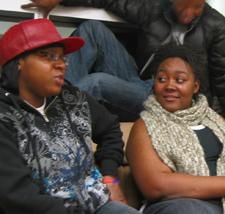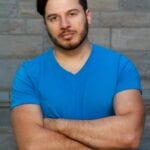I hadn’t expected to be asked to wait. That is the first surprise of the night.
I was invited to observe a meeting of Supporting Our Youth’s group program Black Queer Youth (BQY) so I could report on the black queer experience for Xtra but as a white man I am an outsider so my access to the meeting had to be approved by unanimous and confidential vote among the group members. I am relieved when they vote to let me in.
My nerves are calmed somewhat by the surprising openness the participants exude. One flamboyant teenager enters the room asking each member for a hug before he takes his seat.
The group is being led through a month-long program called OutWords, created by facilitators Kim Crosby and Natalyn Tremblay. Through the program, youth learn to work cooperatively, assert their own identities, relate to each other positively and create queer-positive spaces.
Crosby, who grew up in the Keele and Eglinton neighbourhood after arriving from Trinidad at age 7 tells me it’s important for black queer youth to have a space where they can be open about who they are and meet each other.
“All queer youth are marginalized and the application of being black just adds to that,” says Crosby. “There’s a lack of queer black role models. You don’t see blacks in the photos from the Stonewall riots. You don’t hear that Langston Hughes was gay. We’ve been erased from queer history and black history.”
At one point during the session Crosby asks the group if anyone can name a famous queer black person. After a brief silence, one uncertain participant says “RuPaul.” The room breaks out into laughter and then some suggest hip-hop stars they wish were gay.
For some of the participants BQY provides an important way to meet other youth they can relate to positively.
“It’s not hard to meet black people outside of the group, but you meet for different reasons,” says Khary (all participants’ names have been changed in this story, at their request). “Web sites, for example, but they’re for hookups, not for friends.”
“It’s somewhere to be on a Wednesday night where I can be myself,” says Twisted, another participant.
“There’s things only black people can relate to,” Khary says. “The black community and white community are different. They have more clubs, more places to go, it’s bigger. Clubs don’t have a ‘whites only’ policy, but you can tell it’s more geared to them. The music, the posters, the DJs, even the employees — you don’t see many blacks.”
Crosby says the invisibility of people of colour from the queer community extends beyond the club scene and has repercussions on the black community.
“If you talk to the queer support services, you’ll hear that they haven’t had blacks use their services, but that’s largely because they don’t do outreach to the black communities. Consequently many blacks don’t think queerness belongs to them,” Crosby tells me.
Khary, who lives in the Keele and Finch area, says BQY fills some of the gap in services missing from his nighbourhood.
“There’s a lot of things people in my community are ignorant about, like how you can catch HIV,” he tells me, pointing to HIV-awareness posters and pamphlets strewn about the meeting room.
Ignorance of the queer presence in black communities puts queer youth at risk, says one young woman who lives in the Kipling and Steeles area.
“I can’t wear my rainbow scarf in my neighbourhood,” she tells the group. “There’s a queer woman who lives in my building, and one day when I came home, I found her beaten in a pool of blood in the stairway. She’d been raped. But I couldn’t do anything because then they’d know I was queer too.”
Crosby says this is one of the key differences between the black and white coming out experiences.
“The threat of violence is really prevalent,” she says. “It’s the fear of violence not from strangers, but from your family and neighbours. The space that’s supposed to be the safest becomes the most violent.”
Tremblay, a Franco-Ontarian who moved to Toronto eight years ago, says the problem extends beyond the black communities.
“When white kids move out of home they can feel safe and welcomed anywhere in Toronto,” she tells me. “It’s easy for white queers because we see ourselves as the majority, but we should know that that doesn’t mean it’s the norm.”
“All of our kids have said they’ve felt oppression from other gays, white gays,” Crosby adds. “Kids have told us about guys telling them, ‘I hate niggers,’ or ‘It must take long to get home to Jane and Finch,’ or ‘I don’t like black guys.’”
Ultimately, Crosby and Tremblay say they want black queer youth to be able to address oppression wherever they find it.
“We don’t want to ghettoize these kids [into the gay village]. We want to find ways to get them back into their communities to widen that queer space,” Crosby tells me.
Some of the OutWords participants will go on to do formal outreach work in their communities including sensitivity training for service providers, but Crosby suggests that the biggest impacts may come from smaller-scale outreach.
“Part of this group is just to empower them to come out to their families, so they can bring these sorts of workshops to their families, friends and schools, and create safe spaces for themselves and others,” she says.


 Why you can trust Xtra
Why you can trust Xtra


